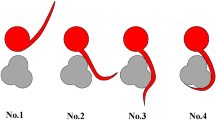Abstract
Artificial structures such as stairs and bumps in roads are critical features that robotic platforms must overcome. Many robotic platforms have been developed for climbing stairs and for overcoming obstacles. However, the agility and maneuverability of the robotic platforms are not yet satisfactory. We propose a new field robot platform design that can climb various sizes of stairs as fast as human beings. The locomotion of the robotic platform is similar to the flipping (or tumbling) locomotion of humans, so we name the robot “FlipBot.” The main body is composed of a tread-wheel mechanism. A supporting leg performs flipping locomotion during stair climbing while the tread-wheel generates the driving force on flat surfaces. Design parameters are optimized using the Taguchi methodology for stable climbing on various sizes of stairs based on kinematic relations. The assembled robot prototype can climb three different sizes of stairs around 1 step per second, which is generally as fast as human walking. We expect the proposed robot platform to be applied to inspection and service robotic applications in indoor environments.
Similar content being viewed by others
Explore related subjects
Discover the latest articles and news from researchers in related subjects, suggested using machine learning.References
Kalakrishnan, M., Buchli, J., Pastor, P., Mistry, M., and Schaal, S., “Learning, planning, and control for quadruped locomotion over challenging terrain,” International Journal of Robotics Research, Vol. 30, No. 2, pp. 236–258, 2010.
Han, S. C., Kim, J., and Yi, H. C., “A novel design of permanent magnet wheel with induction pin for mobile robot,” Int. J. Precis. Eng. Manuf., Vol. 10, No. 4, pp. 143–146, 2009.
Kim, Y. G., Kwak, J. H., Hong, D. H., Kim, I. H., Shin, D. H., and An, J., “Autonomous terrain adaptation and user-friendly tele-operation of wheel-track hybrid mobile robot,” Int. J. Precis. Eng. Manuf., Vol. 13, No. 10, pp. 1781–1788, 2012.
Liu, Y. and Liu, G., “Track-stair interaction analysis and online tipover prediction for a self-reconfigurable tracked mobile robot climbing stairs,” IEEE/ASME Transactions on Mechatronics, Vol. 14, No. 5, pp. 528–538, 2009.
iRobot corporation, “510 PackBot,” http://www.irobot.com/en/us/learn/defense/packbot.aspx (Accessed 22 October 2013).
Quaglia, G., Maffiodo, D., Franco, W., Appendino, S., and Oderio, R., “Epi.q-1 hybrid mobile robot,” International Journal of Robotics Research, Vol. 26, No. 1, pp. 81–91, 2010.
Quaglia, G., Bruzzone, L., Bozzini, G., Oderio, R., and Razzoli, R. P., “Epi.q-TG: mobile robot for surveillance,” Industrial Robot: An International Journal, Vol. 38, No. 3, pp. 282–291, 2011.
Boxerbaum, A. S., Oro, J., Peterson, G., and Quinn R. D., “The latest generation Whegs robot features a passive-compliant body joint,” IEEE/RSJ International Conference on Intelligent Robots and Systems, pp. 1636–1641, 2008.
Saranli, U., Buehler, M., and Koditscheck, D. E., “RHex: A simple and highly mobile hexapod robot,” International Journal of Robotics Research, Vol. 20, No. 7, pp. 616–631, 2001.
Raibert, M., Blankespoor, K., Nelson, G., and Playter, R., “BigDog, the rough-terrain quadruped robot,” Proc. of the 17th World Congress the International Federation of Automatic Control, pp. 10822–10825, 2008.
Murphy, M. P., Saunders, A., Moreira, C., Rizzi, A. A., and Raibert, M., “The LittleDog robot,” International Journal of Robotics Research, Vol. 30, No. 2, pp. 145–149,2011.
Asimo TV, “Honda Going Up Stairs,” http://asimo.honda.com/asimotv/ (Accessed 22 October 2013).
Kim, J. Y., Park, I. W., and Oh, J. H., “Realization of dynamic stair climbing for biped humanoid robot using force/torque sensors,” Journal of Intelligent Robotic Systems, Vol. 56, No. 1, pp. 389–423, 2009.
Seo, T. and Seo, B., “Robots for stairs climbing,” KOR patent, No. 10-2012-0043572, 2012.
Seo, B., Hong, S., Lee, J., and Seo, T., “Kinematic optimal design on a new robotic platform for stair climbing,” J. Korean Soc. Precis. Eng., vol. 30, No. 4, pp. 427–433, 2013.
The National Assembly of the Republic of Korea, http://likms.assembly.go.kr/law/ (In Korean, retrieved at May 2, 2013).
Kim, D., Hong, H., Kim, H. S., and Kim, J., “Optimal design and kinetic analysis of a stair-climbing mobile robot with rocker-bogie mechanism,” Mechanism and Machine Theory, Vol. 50, pp. 90–108, 2012.
Taguchi, G., “Taguchi on Robust Technology Development: Bringing Quality Engineering Upstream,” ASME Press, pp. 273–291, 1993.
Mohsen, M. D. and Majid, M. M., “Stair climber smart mobile robot (MSRox),” Autonomous Robot, Vol. 20, No. 1, pp. 3–14, 2006.
Author information
Authors and Affiliations
Corresponding author
Rights and permissions
About this article
Cite this article
Seo, B., Kim, H., Kim, M. et al. FlipBot: A new field robotic platform for fast stair climbing. Int. J. Precis. Eng. Manuf. 14, 1909–1914 (2013). https://doi.org/10.1007/s12541-013-0259-8
Received:
Accepted:
Published:
Issue Date:
DOI: https://doi.org/10.1007/s12541-013-0259-8



